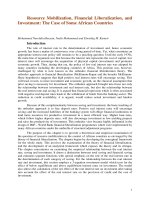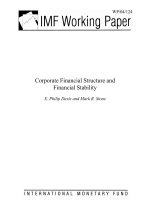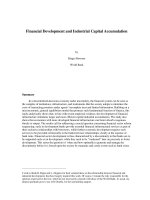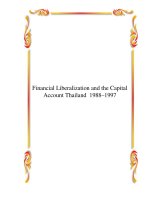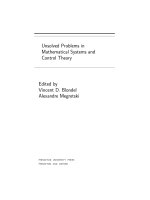Financial systems and auditing assignment 2
Bạn đang xem bản rút gọn của tài liệu. Xem và tải ngay bản đầy đủ của tài liệu tại đây (292.62 KB, 12 trang )
BANKING ACADEMY OF VIETNAM
BTEC HND IN BUSINESS (ACCOUNTING)
ASSIGNMENT COVER SHEET
NAME OF GROUP
REGISTRATION NO.
UNIT TITLE
ASSIGNMENT TITLE
ASSIGNMENT NO
NAME OF ASSESSOR
SUBMISSION DEADLINE
Maple Group
F05A
Unit 11: Financial Systems and Auditing
Working Paper and Audit Report
2 of 2
Dr. Jun Alejo Bathan
6th Jun 2014
We _____Maple Group_____________________ hereby confirm that this assignment is our own
work and not copied or plagiarized from any source. We have referenced the sources from which
information is obtained by us for this assignment.
Signature of members
Date
______6th Jun 2014_________
________________________________
Serial
No
Group member
1
(Vietnamese Name)
Leader:
2
3
4
Ngô Thị Huyền Trang
Vương Thị Quỳnh Anh
Nguyễn Phương Thảo
Nguyễn Thị Kiều Anh
Group member
Student no
Signature
(English Name)
Jess
Lynn
Key
Snow
F05F05F05F05-
----------------------------------------------------------------------------------------------------------------
FOR OFFICIAL USE
Assignment Received By:
Date:
1
1
Unit Outcomes
Outcome
Evidence for the
criteria
Feedback
Assessor’s decision
First
Attempt
Be able to
contribute to
the
planning and
conduct of an
audit
assignment
Plan an audit
with reference to
scope, materiality
and risk
3.1
Identify and use
appropriate audit
tests
3.2
Record the audit
process in an
appropriate
manner
3.3
Prepare a draft
audit report
4.1
Draft suitable
management
letters in relation
to a statutory
audit
4.2
Internal
Verification
Rework
LO3
Be able to
prepare audit
reports
LO4
Merit grades awarded
M1
M2
M3
Distinction grades awarded
D1
D2
D3
Assignment
( ) Well-structured; Reference is done properly / should be done (if any)
2
2
Outcome
Evidence for the
criteria
Feedback
Internal
Verification
Assessor’s decision
First
Attempt
Rework
Overall, you’ve
Areas for improvement:
ASSESSOR SIGNATURE
DATE
/
/
DATE
/
/
NAME:.........................................................................................
(Oral feedback was also provided)
STUDENT SIGNATURE
NAME :..............................................................................
FOR INTERNAL USE ONLY
VERIFIED
YES
NO
DATE
: ...........................................................................
VERIFIED BY : ...........................................................................
NAME
: ...........................................................................
FINANCIAL SYSTEMS AND AUDITING
3
3
Prepared for:
Lecturer, Dr. Jun Alejo Bathan
Unit 11: Financial Systems and Auditing
Banking Academy, Hanoi
BTEC HND in Business (Finance)
Prepared by: Maple Group
Vương Thị Quỳnh Anh - Lynn
Ngô Thị Huyền Trang - Jess
Nguyễn Phương Thảo - Key
Nguyễn Thị Kiều Anh - Snow
Submitted: 06/06/2014
3.3 Record the audit process in an appropriate manner
3.3.1 Working papers
Working papers mean the record of audit procedures performed, relevant audit evidence
obtained and conclusions the auditor reached. It may be in the form of data stored on
4
4
paper, film, electronic media or other media. In order to support audit process, the
working papers are prepared that must be sufficient, appropriate and follow
ISAs...Besides, the data included in working papers should be focus on important and
necessary aspects and follow a suitable arrangement in format. Thus for avoiding errors
of documenting and save time, Burton Housing should use automated working paper
packages (computerized working paper) that helps company to make the documenting of
audit work much easier. These are automatically cross referenced and balanced by the
computer. Wherever an adjustment is made, the computer will automatically update all
the necessary schedules (BPP, 2010).
Content and format of working papers
•
-
-
Typical contents of working papers
Information concerning the legal and
organizational structure of the client
Information concerning the client’s
industry, economic and legal environment
Evidence of the planning process
Evidence of the auditors’ understanding of
the accounting and internal control
systems
Evidence of inherent and control risk
assessments and any revisions
Analyze of transactions and balances
Analyze of significant ratios and trends
A record of the nature, timing, extent and
results of auditing procedures
Copies of communication with other
auditors, experts and other their parties
Copies of correspondence with the client
Reports to directors or management
Notes of discussions with the entity’s
directors or management
Notes of discussions with the entity’s
directors or management
A summary of the significant aspects of
the audit
Copies of the approved financial
statements and auditors’ reports.
-
Format of working papers
The name of the client
The balance sheet date
The file reference of the working
paper
The name of the person preparing
the working paper
The date of working paper was
prepared
The subject of the working paper
The name of the person reviewing
the working paper
The date of the review
The objective of the work done
The sources of information
The work done
A key to any audit ticks or symbols
The results obtained
Analysis of errors or other
significant observations
The conclusions drawn
Table: The contents and format of working papers (BPP, 2010)
•
Standardized working papers
In order to improve the efficiency for preparing and reviewing of working papers,
checklists, standard audit programmes, and specimen letter should be used.
There are some advantages and disadvantages that Burton Housing should consider
before using standardize working papers:
5
5
Advantages
-
Improve the efficiency
-
Provide a guideline for auditors in order to control the quality of audit that meet
the minimum requirements
-
Ensure that all audit areas are done
Disadvantages
•
-
The staffs of clients also can follow and do the audit with the method
-
Less initiative, work is mechanical (BPP, 2010)
Audit files
For recurring audits, working papers may be split between permanent and current
audit files
- Permanent audit files are updated with new information of continuing
importance
such
as
legal
documents,
background
information
and
correspondence with the client of relevance for a number of years.
- Current audit files contain information relating primarily to the audit of a
single period (BPP, 2010).
3.3.2 Recording of accounting and control systems
There are several techniques for recording accounting and internal control systems:
•
Narrative notes
•
Flow charts
•
Questionnaires
•
Checklists
A combination may be used, with narrative notes and/or flowcharts recording the accounting
systems, the questionnaires recording control
a)
Narrative notes
Narrative notes are easy to record but are difficult to change if written manually. Editing
in future years will be easier if they are computerized. Its purpose is to “describe and
explain the system, at the same time making any comments or criticisms which will help
to demonstrate an intelligent understanding of the system”. Narrative notes can be used to
support for flowcharts. (BPP, 2010).
In case of Burton Housing - a small charity and housing association, by using narrative
notes, it can record the system of daily transactions in the restaurant easier. All
transactions/documentation can be handled by just one or two persons. The auditor can
confirm existence of transactions/records by the means of walk through tests. It helps
auditor evaluate operating system in order to decide if the system notes is suitably
6
6
designed and constitutes a reliable basis for the preparation of the financial statement.
From that, auditor can recommend for Burton Housing way to change its system if
necessary.
b)
Flow charts
Flowcharts are a great tool to use to visualize complex systems involved in an
organization and are easier and less time consuming for someone to understand than a
narrative. By placing everything in a visual manner it will be easier for an auditor to see
the redundancies and an organization's system of internal accounting control (Ivanko,
n.d.).
There are two methods of flowcharting in regular use:
•
Document flowcharts: A document flowchart emphasizes the hardcopy inputs and
outputs and their flows through organizational units. Auditors and accountants may
use document flowcharts when analyzing a current system for weaknesses in controls
•
and reports
Information flowcharts: Information flowcharts are prepared in the reserves
direction from the flow: they start with the entry in the accounting records and work
back to the actual transaction. They concentrate on significant information flows and
key controls and ignore any unimportant documents or copies of documents (BPP,
2010).
7
7
Table: Flow charts of Burton Housing’s purchasing food
8
8
A check function
An operation
File (N = numerical order)
Document flow
Information flow
3-part document
Document
Ledger
Table: Flowchart’s symbols
9
9
c)
Questionnaires
There are two types of questionnaires, including Internal Control Questionnaires (ICQs)
and Internal Control Evaluation Questionnaires (ICEQs)
Purposes
Principles
Design
Advantages
Disadvantages
Examples
ICQs
For certain controls exist
ICEQs
Identify whether whatever controls the
system fulfilling specific objectives or
relying on that to prevent weakness
assess specific
errors/ frauds
- Comprise a list of questions to Control questions
determine present desirable controls
- Formulated, so there is on to cover
each of the major transaction cycle
List of questions with the answer of Yes List of questions with Yes or No
or No
answer
“No” answer indicates for the
“Yes” answer would require
weaknesses of system
explanation
- Consider all controls
- Easier to apply
- Prepare quickly
- Enable to identify the most
- Easy to use and control
important controls
- Could highlight the areas of
weakness with required extensive
substantive testing
- Overstated controls for respondents
- Drafted vaguely
- Include large number of irrelevant - Misunderstood
controls
- Not identify important controls
- Not include unusual controls which
are
effective
in
particular
circumstances
For goods inward:
For sale cycle:
- Are suppliers examined on arrival - Sales are properly authorized?
as to quality and quantity?
- Sales are made to reliable payers?
- Is the receipt of supplies recorded?
- All goods dispatched are invoiced?
Table: The different types of questionnaires (BPP, 2010)
In case of Burton Housing, questionnaires are issued after each audit has been completed.
The questionnaires are issued with the aim of assessing their views on the audit process. It
provide opportunities to respond to any arising issues timely and allows internal audit team to
understand what is working well and areas where the process can be improved.
YES
NO
N/A
Rent Procedure
Is the rent system operating effectively?
Is information about allocating rooms to individual sent to
bookkeeper from housing manager?
Are the rents posted to each resident’s account on the sales ledger
each week?
10
10
Is rents received from residents by reception staff who are
independent of housing manager and bookkeeper?
Is reception staff responsible for giving rents to the bookkeeper?
The bookkeeper posted cash received for rents to the sales ledger,
enters them in the cash book and pays them into the bank?
The housing manager reports void (room unlet) to the management
committee?
Purchasing food procedures
Is the purchasing food system operating effectively?
Is the food ordered by sending an order to the supplier by restaurant
manager?
Is the food received checked by the restaurant manager?
Is the purchase invoice authorized to confirm the food has been
received by the restaurant?
The bookkeeper posts the purchases invoices to the payables ledger?
The bookkeeper makes out the cheques to pay the suppliers?
Are the cheques posted to the payables ledger and cash book?
d)
Checklists
Figure: Example of Internal control audit document review checklist
11
11
An internal audit checklist is an important road map that enables corporations to identify
potential problems in their operating activities. More importantly, the checklist helps internal
auditors conduct corporate reviews in accordance with generally accepted auditing standards.
It also enables auditors to review internal processes in conformity with Institute of Internal
Auditor guidelines (Codjia, n.d.). Therefore, it might be useful tool in audit process of Burton
Housing.
Works Cited
BPP, 2010. In Auditing and Financial Systems and Taxation. London: BPP Learning Media Ltd.
Codjia, M., n.d. Internal Audit Checklist Guide. [Online] Available at:
[Accessed 24 May 2014].
Ivanko, M., n.d. The Advantages of Flowcharts for an Auditor. [Online] Available at:
[Accessed 24 May 2014].
12
12
